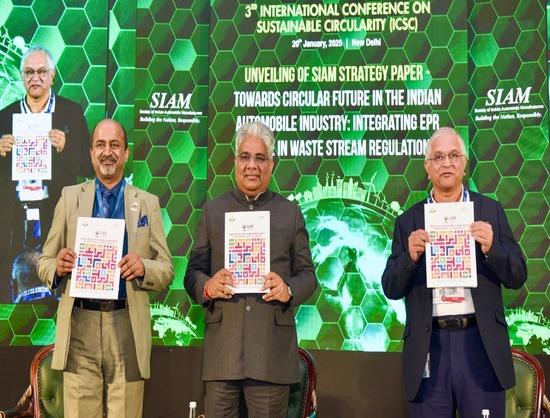Our Terms & Conditions | Our Privacy Policy
Bhupender Yadav Stresses Dual Responsibility of Automotive Industry at SIAM Conference – Asia Pacific
Union Minister Bhupender Yadav highlighted the automotive sector’s dual responsibility to drive economic growth while ensuring environmental sustainability. Speaking at SIAM’s 3rd International Conference, he emphasised the need for ‘Nature Positive Recycling’ and advancing India’s green initiatives.
January 20, 2025. By EI News Network
Union Minister for Environment, Forest, and Climate Change, Bhupender Yadav, emphasised the need for the automotive industry to balance economic growth with environmental sustainability, drawing inspiration from nature’s efficient recycling systems.
He was speaking at SIAM’s 3rd International Conference on Sustainable Circularity, themed ‘Nature Positive Recycling’. Organised by the Society of Indian Automobile Manufacturers (SIAM) in New Delhi, the event brought together leaders from the automotive industry to discuss sustainable development and the transition to a circular economy.
In his keynote address, Yadav highlighted India’s emergence as the third-largest automotive market globally and urged the industry to adopt ‘Nature Positive Recycling’ practices to minimise waste and promote a circular economy. He stressed the importance of reducing reliance on raw materials, conserving the environment by curbing emissions, and creating green jobs.
Yadav also praised Prime Minister Narendra Modi’s ‘Waste to Wealth’ initiative, which focuses on transforming waste management into resource optimisation. He outlined government policies supporting sustainability in the automotive sector, such as the Vehicle Scrappage Policy (2021), which mandates replacing older vehicles with BS-VI-compliant models to reduce harmful emissions. He also pointed out the End-of-Life Vehicles (ELVs) Rules, effective April 2025, which promote environmentally responsible scrapping through Extended Producer Responsibility (EPR).
The Minister noted the significant progress in electric vehicle (EV) adoption, driven by the FAME and PLI schemes. He projected that EV sales would reach 35 percent by 2030, saving 5 million tonnes of CO2 annually.
Emphasising the automotive sector’s role in achieving Sustainable Development Goals (SDGs), particularly SDG 7 (Affordable and Clean Energy), SDG 8 (Decent Work and Economic Growth), and SDG 9 (Industry, Innovation, and Infrastructure), Yadav called on the industry to design recyclable vehicles, ensure sustainability in operations, and enhance consumer awareness about environmental conservation. He also encouraged participation in afforestation drives like the ‘Ek Ped Ma Ke Naam’ campaign to combat air pollution.
Yadav concluded the session by unveiling SIAM’s strategy paper, ‘Towards a Circular Future in the Automobile Industry: Integrating EPR Regime in Waste Stream Regulation.’ He reiterated the dual responsibility of the automotive sector to drive economic growth while safeguarding environmental sustainability, reaffirming India’s commitment to a sustainable and circular future.
Images are for reference only.Images and contents gathered automatic from google or 3rd party sources.All rights on the images and contents are with their legal original owners.



Comments are closed.